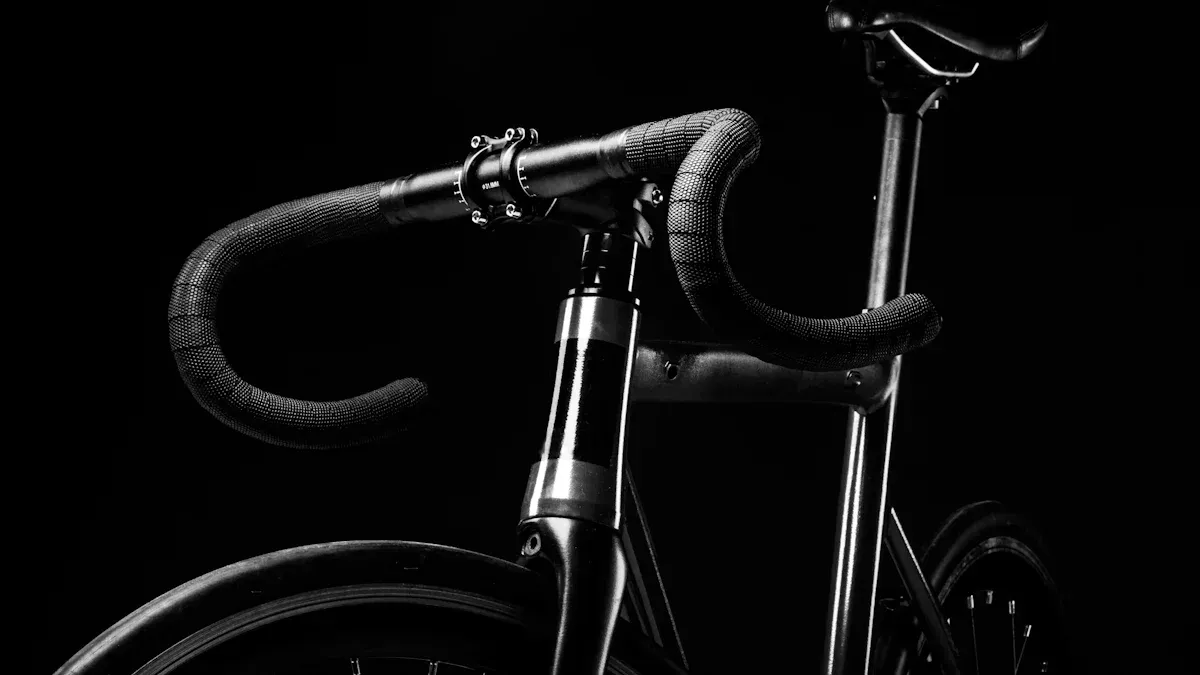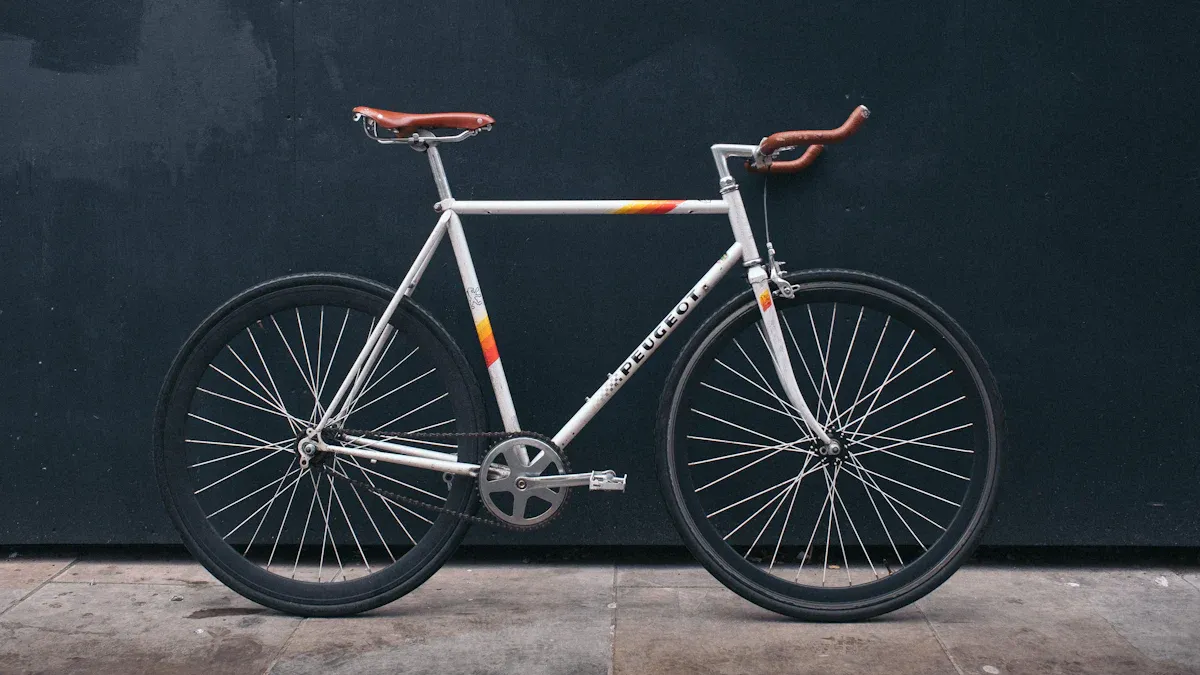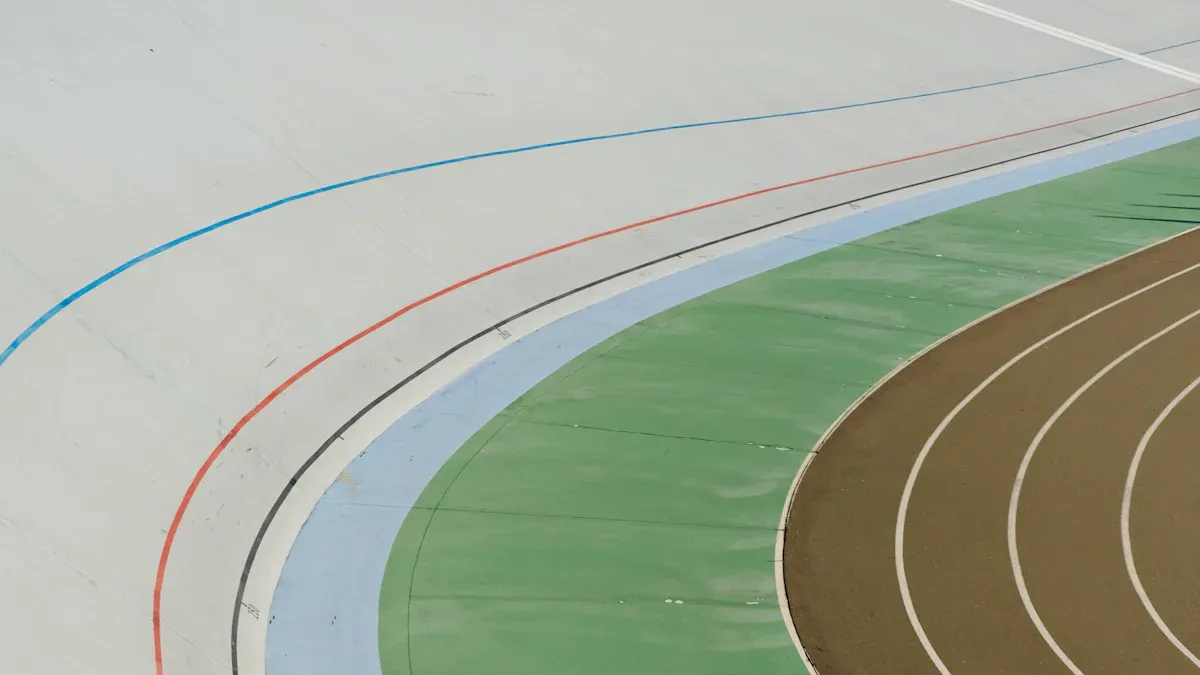
A frame track bike is distinct from other bike frames due to its unique shape, components, and intended use. A frame track bike features a higher bottom bracket, a steeper headtube angle, and a shorter wheelbase, all designed to enhance quick turning on the track. However, these characteristics make a frame track bike less stable for street riding. Many people mistakenly believe a frame track bike is simply a fixie without brakes, but a true frame track bike lacks brake mounts and offers limited tire clearance. The table below highlights the key differences between a frame track bike and a road bike frame:
Aspect | Frame Track Bike | Road Bike Frames |
|---|---|---|
Headtube Angle | Steeper angles (around 75˚) for responsiveness | More relaxed angles (~73˚) for comfort |
Seattube Angle | Steeper angles for aggressive riding position | Less steep for comfort on longer rides |
Bottom Bracket | Raised to avoid pedal strike (2-3 cm higher) | Lower for stability and easier foot placement |
Wheelbase | Shorter for quick handling and twitchiness | Longer for stability and comfort |
Fork Rake | Lower rake for sharper responsiveness | More rake for smoother handling |
Frame Stiffness | Stiff and twitchy, optimized for track racing | More compliant for comfort over long distances |
Brake Mounts | Often absent, as brakes are not used on tracks | Present for road safety and versatility |
Tire Clearance | Limited, designed for narrow tires | Greater clearance to accommodate wider tires |
Intended Use | Short, high-intensity track racing | Longer rides, comfort, and varied terrain |
Key Takeaways
Track bike frames have sharp angles and a high bottom bracket. This helps riders turn fast and pedal safely on smooth, sloped tracks. These frames use fixed gears and do not have brakes. This makes them simple and light. They are great for racing but not safe for riding on streets. Rear-facing dropouts help riders adjust the chain tension easily. This is important because track bikes do not use derailleurs or chain tensioners. Track bike frames are stiff and light. They are made to move power well and help riders go faster in short, hard races. For daily riding, road, fixie, or commuter bike frames are better. They give more comfort, safety, and can be used in more ways than track bike frames.
Track Bike Frame Geometry

Steep Angles
Track bike frames have steeper head tube and seat tube angles. These angles are usually about 75 degrees. Steep angles put the rider over the pedals more. This helps riders speed up fast and keep high speeds. The sharp angles make the bike react quickly. Riders can turn fast with little effort. This is important for sprints and tight turns on a velodrome. Road bikes have more relaxed angles for comfort and stability. Track bikes give up comfort to be faster and more agile.
High Bottom Bracket
Track bike frames have a higher bottom bracket than other bikes. Most track bikes have bottom brackets about 11 inches high or more. This design helps stop pedal strikes in sharp turns. On banked tracks, this is very important. When turning, the inside pedal drops low. A higher bottom bracket keeps the pedal away from the ground. This stops it from hitting the track. Road bikes have lower bottom brackets, about 10.5 to 10.75 inches. This makes them more stable and easier to stop. Track frames focus on keeping pedals clear and safe during fast turns.
Note: The higher bottom bracket on a track bike frame is very important for racing on steep tracks. It lets riders pedal through corners without hitting the pedals.
Shorter Reach and Top Tube
Track bike frames have a shorter reach and a smaller top tube. This makes the handlebars closer to the rider. The short reach puts the rider in a forward, aerodynamic position. Riders can use more power and control at high speeds. The compact shape makes the bike feel quick and easy to handle. Fast handling helps in tight groups and sudden moves during races. Road bikes have longer top tubes and reach for comfort and stability on long rides.
Rear-Facing Dropouts
Track bikes have rear-facing horizontal dropouts. This is a special part of their frame. These dropouts let the back wheel move backward in the frame. Riders can adjust the chain tension by moving the axle. Track bikes do not use derailleurs or chain tensioners. So, the chain tension must be just right. Some track frames have chaintugs to keep the chain tight. Chaintugs also stop the axle from moving during hard pedaling. Rear-facing dropouts help keep the wheel lined up straight. This helps both chain tension and the bike’s shape. Road and commuter bikes use vertical dropouts. These do not let you adjust the chain this way and need extra parts for chain tension.
Rear-facing dropouts on a track bike frame:
Let you adjust chain tension by moving the wheel back.
Help keep the wheel lined up for best performance.
Often have chaintugs to stop the axle from moving.
Remove the need for derailleurs or outside chain tensioners.
Track bike frame geometry uses all these features for speed and control. Each part, from steep angles to rear-facing dropouts, helps make track bikes great for racing on velodromes.
Track Bike Components
Fixed Gear Only
A track bike frame always uses a fixed gear setup. Riders cannot coast or stop pedaling because the pedals move with the rear wheel. This design means the bike frame does not need derailleurs or shifters. The single gear ratio on a track bike frame reduces friction and weight. Riders get efficient power transfer and a direct connection to the track. On flat tracks, this setup helps maintain high speeds. However, track bikes cannot change gears for hills or wind. Road bikes and fixie bikes often use multiple gears or freewheels for more flexibility.
Fixed gear bikes need less maintenance than geared bikes:
Fewer parts can break or wear out.
No derailleurs or shifters to adjust.
Quality fixed gear bike frames last longer and need less care.
Simpler design means fewer repairs.
Riders who use fixed gear bikes daily find them reliable and easy to maintain.
A fixed gear bike frame works best on a smooth track. Fixie bikes for the street may look similar but often have different gear options or freewheels.
No Brakes or Mounts
Track bike frames do not have brakes or brake mounts. On a velodrome, the track is smooth and controlled. Riders use their legs to slow down by resisting the fixed gear. This setup keeps the bike frame light and simple. Brakes could cause sudden stops, which are dangerous in close racing groups. Track bikes rely on rider skill and track rules for safety. Road bikes, fixie bikes, and commuter bikes always have brakes for stopping in traffic or emergencies.
Note: The lack of brakes on a track bike frame is safe only on a velodrome. Riders should never use a true track bike on the street without brakes.
Wheel and Tire Fit
Track bike frames use specific wheels and tires for racing. Most track bikes use 700c wheels, but some smaller frames use 650c. The tires are narrow and slick for speed on smooth tracks. Track bike frames do not fit wide tires or treaded tires. Road bikes use 700c wheels too, but they allow wider tires for comfort. Commuter bikes use even wider tires for grip and safety on mixed surfaces.
Bike Type | Common Wheel Sizes | Tire Widths (mm) | Tread Pattern |
|---|---|---|---|
Track Bike | 700c, some 650c | Narrower than road tires | Slick for smooth tracks |
Road Bike | 700c | 23-35 | Slick or semi-slick |
Commuter Bike | 700c | 35-45+ | Semi-slick, grippy |
Track bike frames require special hubs and parts. Not all road or fixie bike wheels fit a true track bike frame. Riders must choose the right wheels and tires for the best performance on the track.
Track Bike Use and Performance

Velodrome Racing
Track bike frames are made for racing on velodromes. They use light and stiff materials like carbon fiber and aluminum. This helps riders go faster and control the bike better. Track bikes have steep angles and short top tubes. The rear triangle is tight. These choices make the bike react quickly and handle well on the track. The bikes have shapes that cut through air. Cables are hidden, and wheels are deep-section. This helps lower air resistance. Riders use only one fixed gear and no brakes. This keeps the bike simple and light. Track bikes work best on smooth, banked tracks. Speed and control are most important here. Road and commuter bikes have features for comfort or gear changes. Track bikes do not. Track racing needs fast starts and sharp turns. Every part of the bike helps with these needs.
Key features for velodrome racing:
The frame is light for speed.
Stiffness helps riders use their power.
The shape is made to cut through air.
Fixed gear gives direct control.
No brakes keep things safe in groups.
Power Transfer and Stiffness
Track bike frames are very stiff to help riders use their power. When a rider pedals hard, a stiff frame sends more energy to the track. Road bike frames try to balance stiffness and comfort. They use carbon fiber or aluminum. Commuter bikes use heavier materials. These soak up bumps and shakes. This makes them less good at sending power to the wheels. Track bikes use the stiffest frames, wheels, handlebars, and chainsets. This helps riders start fast and keep high speeds in sprints. Stiffness is key for track racing. Comfort and the ground also matter for speed. On a velodrome, stiffness gives riders an edge.
Aggressive Position
Track bike shapes put riders in a forward, aggressive spot. Steep seat tube angles move the rider forward. This helps pedaling and spreads weight better. Higher bottom brackets let riders lean more in turns. This stops pedal strikes. Shorter chainstays keep the bike’s weight in the middle. This helps with quick starts and control. Steep head tube angles make steering faster. This helps with quick turns. The table below shows how these features help riders on the track.
Geometry Aspect | Biomechanical Advantage |
|---|---|
Steeper Seat Tube Angle | Helps riders pedal better and use more power |
Higher Bottom Bracket | Lets riders turn tight without hitting pedals |
Shorter Chainstay | Keeps weight in the middle for fast starts |
Steeper Head Tube Angle | Makes steering and turning faster on tight tracks |
Ian, who is an expert in bike fitting, says an aggressive position can boost speed and power. Riders must feel okay to hold this posture. If it feels wrong, they lose speed and get tired faster. Track bikes are best for riders who can stay in this position during hard efforts.
Note: Track bikes are not good for street or road riding. The stiff frame, no brakes, and aggressive spot make them hard to control and not comfy off the track. A real track bike should stay on the velodrome for safety and best results.
Frame Track Bike vs. Other Bikes
Comparison Table
The table below shows how different bike frames compare. Each bike frame is made for a special use. Track bikes are built for speed and control on tracks. Road and commuter frames are made for comfort and safety every day. Fixie frames mix some track features with parts for city riding.
Feature | Frame Track Bike | Road Bike Frame | Fixie Frame | Commuter Frame |
|---|---|---|---|---|
Intended Use | Track racing | Road riding | Urban, casual | Daily commuting |
Geometry | Steep angles, high BB | Relaxed angles, lower BB | Moderate angles | Relaxed, upright |
Dropouts | Rear-facing | Vertical | Horizontal/vertical | Vertical |
Brakes | None | Dual brakes | Usually present | Always present |
Tire Clearance | Narrow, limited | Wider, flexible | Wider than track | Wide, for comfort |
Durability | Stiff, less durable | Balanced | Durable for city | Most durable |
Bike Frame Materials | Carbon, aluminum | Carbon, aluminum, steel | Steel, aluminum | Steel, aluminum |
Price Range | $100-$500 | $500+ | $100-$500 |
Key Differences Summary
A frame track bike is different because of its shape and parts. It has steep angles and a high bottom bracket for fast moves on the track. Track bikes use rear-facing dropouts, have no brakes, and fit only narrow tires. These things make them great for racing but not safe for streets.
Track bike frames use stiff and light materials for speed. Carbon and aluminum help riders go fast and turn quickly. Road and commuter frames use materials that make rides smoother and last longer. Fixie frames add brakes and wider tires for safer city rides.
Experts say the shape and how the bike handles are most important. Track bike frames feel quick and stiff. Road and commuter frames are more comfy and steady. Track bikes cost more because of their special shape and materials. Used road and commuter frames are cheaper and easier to buy.
Track bikes are best for smooth tracks. Other bike frames are better for daily rides, going to work, or rough roads. Riders should pick a bike frame that fits how and where they ride.
Tip: If you want a bike for every day, pick a road, fixie, or commuter frame. A frame track bike is best for racing on tracks.
A track bike frame is easy to spot. It has steep angles and a high bottom bracket. It also has rear-facing dropouts. These parts help riders go fast and stay in control on the track. The table below shows how each part changes how happy riders are with their bikes:
Component | Track Bike Frame (Racing) | Other Bike Frame (Commuting, Touring) | Impact on Satisfaction |
|---|---|---|---|
Chainstay | Short | Long | Agility vs. comfort |
Fork Material | Carbon fiber | Steel or aluminum | Lightweight vs. durability |
Wheel Size | 650c | 700c | Maneuverability vs. efficiency |
When picking a bike frame, riders should think about a few things. They should look at the frame material and shape. This helps the bike fit well and handle better on the track. Aerodynamics and weight matter for racing. Comfort and how long the bike lasts are important for everyday use.
A track bike frame is made for racing on a velodrome. Other bike frames are better for daily rides, comfort, and easy care.
FAQ
What makes a track bike frame different from a fixie frame?
A track bike frame has no brake mounts and uses rear-facing dropouts. Fixie frames often include brake mounts and allow wider tires. Track frames focus on racing, while fixie frames work better for city riding.
Tip: Riders should check for brake mounts before using a bike on the street.
Can someone use a track bike frame for daily commuting?
Track bike frames do not suit daily commuting. They lack brakes and tire clearance for rough roads. Riders may find the aggressive position uncomfortable. Road or commuter frames offer more comfort and safety.
Why do track bike frames use only fixed gears?
Track bike frames use fixed gears for direct power transfer. Riders cannot coast. This setup helps control speed on the track. Fixed gears also reduce weight and make the bike simpler.
Feature | Track Bike Frame | Road Bike Frame |
|---|---|---|
Gear Type | Fixed | Multiple |
Coasting | No | Yes |
Are track bike frames safe for street riding?
Track bike frames are not safe for street riding. They do not have brakes. The stiff frame and narrow tires make handling difficult on rough surfaces. Riders should choose a bike with brakes for city use.
See Also
Key Differences Between Fat And Mountain Bike Frames
Unique Qualities That Make Titanium Bike Frames Stand Out
Essential Materials For Track Bike Frames And Their Importance
How To Choose The Perfect Bike Frame For Yourself
Important Factors To Consider When Comparing Bike Frame Sizes
